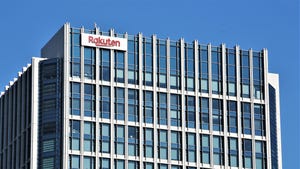AWS brings 1984 to the edge
The adjective ‘Orwellian’ is overused, not least by this publication, but what do you expect when you launch industrial IoT services with names like ‘Monitron’?
December 2, 2020

The adjective ‘Orwellian’ is overused, not least by this publication, but what do you expect when you launch industrial IoT services with names like ‘Monitron’?
That’s just one of many announcements coming from the latest AWS re:Invent three week jamboree, during which Amazon Web Services gets to reveal its latest progress in automating the world. Many of these involve bringing cloud cleverness to the edge of the network and the most eye-catching was a suite of services concerning ‘industrial machine learning’.
Most of them, as the collective name implies, concern industrial IoT and seem genuinely useful. They focus on AI-boosted monitoring of equipment to see if it’s working properly and diagnose the symptoms if it’s not. The thinking is that this significantly cuts the number of technicians you need to employ and the level of training even those few remaining ones need, because the AI does most of the heavy lifting. Then you just need to send some minimum-wage drone to perform simple, repetitive tasks as required.
That’s all fine, but then the geniuses at AWS decided Monitron was a great name for something that keeps an eye on everything. The same brainstorming session, presumably, also yielded something benignly-named AWS Panorama, which uses computer vision to improve industrial operations and workplace safety.
Everyone wants a safer workplace, right? But at what cost to privacy and liberty? This ‘computer vision’ (i.e. networked CCTV cameras) will spy on workers to make sure they’re complying with best practice such as driving forklifts properly and social distancing coz of coronavirus. If they don’t, we imagine a Punishertron 4000 drone can be automatically dispatched to deal with the errant unit.
On a lighter note, Vodafone announced it will be the first European operator to offer MEC (Mobile Edge Computing) solutions based on AWS Wavelength, a service suite designed to facilitate MEC applications such as autonomous vehicles and lagless live video.
When we were at the peak of the 5G hype cycle, it was all about more bandwidth, massive IoT, low latency and combinations therein. It was obvious at the time that the only really novel part of the 5G triangle was low-latency since we already had IoT and bandwidth is a constantly evolving commodity. Basic physics means the less distance a signal has to travel, the less latency it will suffer, which is why MEC is a big deal.
So Vodafone seems wise to be focusing on this sort of thing as a way to get some return on its 5G investments. The AWS Wavelength initiative seems to be all about offering 10 millisecond latency to businesses and developers to do things like robotic surgery with. It’s also building a commercial MEC centre in London, all of which will start to become reality early next year.
“Every millisecond matters in digitalising manufacturing, safeguarding citizens and workers, transporting medical supplies by drone or eliminating motion sickness when wearing a VR headset,” said Vodafone CTO Johan Wibergh. “Putting these services much closer to the customer with Vodafone’s Edge Computing service will significantly reduce any delay in transmitting critical services. By opening up new innovation hubs within our 5G network, which currently spans 127 cities and nine markets in Europe, we can help turn new business ideas into commercial successes.”
“Working with AWS on edge computing means we are making it simpler for both independent software vendors and our customers to experiment with this emerging technology,” said Vinod Kumar CEO of Vodafone Business. “We’re doing this by offering an incubation space to create and test applications that we can then industrialise and scale. And we’re already seeing some innovative applications that provide positive business outcomes from Dedrone, Digital Barriers, HERE Technologies, Groopview, and Unleash live, with so much more to come once our MEC innovation programme is running.”
Not everything AWS does is dystopian, of course, but as it moves further into IoT and automation it seems an increasing proportion of it is. Much of the stuff coming out of AWS re:Invent seems designed to render human beings obsolete and to de-skill those lucky few that are still required. We’re no luddites here at Telecoms.com and acknowledge that technological progress is both desirable and inevitable, but we think Amazon could do a much better job of sugaring the pill than by launching products called the Monitron.
UPDATE – 09:00 3/12/20 – Amazon got in touch overnight.
Hi, Scott.
I saw your article, and I wanted to flag that your depiction of Amazon Monitron AWS Panorama are factually and technically inaccurate and need to be corrected. I’ll list each issue for you along with an explanation:
You state:
“The thinking is that this significantly cuts the number of technicians you need to employ and the level of training even those few remaining ones need, because the AI does most of the heavy lifting. Then you just need to send some minimum-wage drone to perform simple, repetitive tasks as required.” This is just factually wrong. Amazon Monitron and Amazon Lookout for Equipment are designed to help customers and their teams of skilled technicians and engineers be more effective and productive in their roles. These services provide alerts and insights for when abnormal equipment behavior is detected so that skilled technicians or engineers can investigate and correct the cause. In the past, collecting the data needed to build predictive maintenance solutions was very challenging, and even in instances where it was possible, deriving insights from the information was difficult. Amazon Monitron and Amazon Lookout for Equipment solve these problems and create new opportunities for customers to improve their operational efficiency, reduce costs, and improve safety.
“the geniuses at AWS decided Monitron was a great name for something that keeps an eye on everything.” This is actually technically inaccurate. Amazon Monitron simply does not perform such a task. Monitron is an end-to-end machine monitoring system comprised of sensors, a gateway, and a machine learning service to detect anomalies and predict when industrial equipment will require maintenance.
In regard to AWS Panorama, you ask, “But at what cost to privacy?” All machine learning inference happens locally on the AWS Panorama appliance and data never has to leave the customer’s facility. The customer controls how and where any outputs are transmitted or consumed. Customers can choose to encrypt their incoming video streams as part of a standard security process for highly sensitive content. Once content is on the device, it is automatically encrypted at rest. Content that has been encrypted is rendered useless without the applicable decryption keys.
This ‘computer vision’ (i.e. networked CCTV cameras) will spy on workers to make sure they’re complying with best practice such as driving forklifts properly and social distancing coz of coronavirus. AWS Panorama does not include any pre-packaged facial recognition capabilities, therefore, any analysis it performs on video streams is intrinsically agnostic of any individual’s identity.
Much of the stuff coming out of AWS re:Invent seems designed to render human beings obsolete and to de-skill those lucky few that are still required. This is not accurate, and actually, the opposite is true. Amazon Monitron and Amazon Lookout for Equipment are designed to help customers and their teams of skilled technicians and engineers be more effective and productive in their roles. These services provide alerts and insights for when abnormal equipment behavior is detected so that skilled technicians or engineers can investigate and correct the cause. In the past, collecting the data needed to build predictive maintenance solutions was very challenging, and even in instances where it was possible, deriving insights from the information was difficult.
Please let me know when you’ll be able to update your story. If you have any additional questions, I would be happy to provide more information on our new services.
About the Author
You May Also Like












_1.jpg?width=300&auto=webp&quality=80&disable=upscale)
